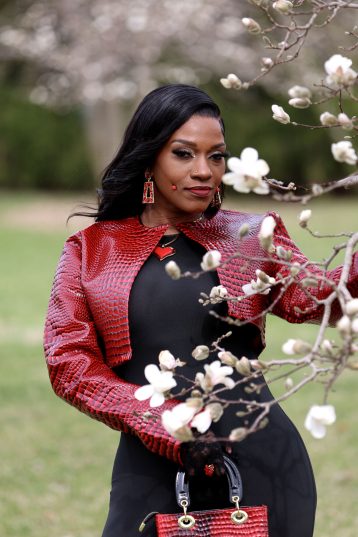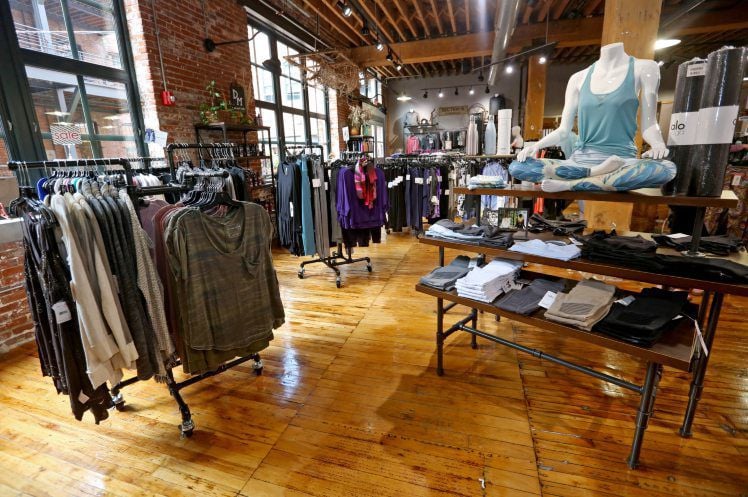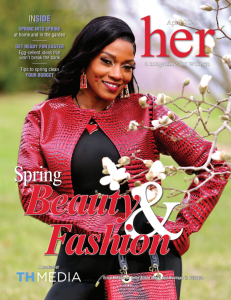Even after years of encouraging girls to become more involved in science, technology, engineering and math, women remained underrepresented in those fields.
The most prevalent discrepancy is in the science and engineering careers, according to a 2017 Girls Collaborate Project study. Whereas the overall workforce breaks down 50% men and 47% women, in the S&E fields, it’s 72% men and 28% women.
We profiled five area STEM teachers to find out how they are reaching students, especially girls.
Ann Arnold, age 34Family: Husband Todd; children Cali (8), Jason (6), Molly (3).
Hometown: Dubuque.
School(s): Alternative Learning Center, math teacher; Robotics coach for students of Dubuque Hempstead and Senior high schools, and ALC.
Classes/levels you teach: Geometry, algebra I, modeling with mathematics and problem solving with robotics; mostly 11th and 12th graders.
How did you become interested in this field?
About six years ago, one of my students wanted to learn more about game design. He wanted to create his own video games. He asked me for help. His interest gave me new life in my profession. I learned about computer programming and robotics.
I developed a curriculum to use in my classroom that combines computer programming, robotics and engineering to teach students 21st-century skills that could help them develop job skills.
Describe your teaching style/approach:
My robotics course is presented in an alternative way, where students earn credit for “playing.” I will give them daily tasks to complete with their robot. A task might be to have their robot travel down the hall and return. The task seems easy, but there are a lot of steps and obstacles students must work through to be successful.
My students must learn how to fail forward. They might not know where to start, so I tell them to start anywhere and learn from their mistakes in order to make appropriate adjustments.
Describe a success story or memorable moment from your career:
Being involved in the Dubuque Robotics High School First Tech Challenge and First Robotics Competition teams has been the most memorable part of my career so far. Seeing our FRC team win the Rookie All-Star Award last March at the Iowa Regional was the highlight of my career. The award meant our team’s hard work was worth it.
Why do you believe it’s important that girls get exposure to STEM courses?
Girls need to know STEM careers exist. I grew up with two older brothers who both went into technology fields. I became a math teacher. I always was asked why I didn’t go into computers. I didn’t have an answer until now. I couldn’t see myself in the field. I didn’t know what it looked like. Once I played with my first robot, I fell in love.
If I had exposure to robotics in school, my future might be different. I might be some kind of engineer. Girls need to know what engineering is. Engineers solve problems: They build things to solve problems for people. Engineering is field about helping people.
Angie Breitbach, 39
Family: Husband, Mike; sons Cohen (12) and Joah (8).
Hometown: Dubuque.
School: Hempstead High School.
Classes/levels you teach: Physics and Honors Physics with Precalc.
How did you become interested in this field?
I’ve always loved kids and science, so teaching seemed like a natural fit. I initially thought I would enjoy teaching biology and life science, but I quickly found my passion in the physical science realm. There was always so much more to discover, more math, and frankly it challenged me. I wanted to be involved making something that really applied scientific principles to everyday life and I found that teaching physics.
Describe your teach style/approach:
I know I’m definitely not the stereotypical physics teacher, as my classroom is always a flurry of activity with students applying things they’ve learned to real world applications or discovering how the world works. It is not usual to see students designing lab experiments, building test models, or collaborating on math concepts.
I act more as a guide to authentic science than the authority at the front of the room. Science doesn’t stop at the door to my classroom, it’s expeditionary.
Describe a success story or memorable moment from your career:
This past year my students developed a plan for a grandma who was afraid of falling in her new apartment. Armed with their physics knowledge about friction and an assortment of flooring and shoe samples, students went to work. They eventually designed a shoe tread so Grammy could join them out ice fishing!
The application of the base concept, their interaction with the math behind their recommendation, their problem solving, and their creativity were all on full display each and every day we worked on this project, and that is how I know this was an incredibly successful lesson.
Why do you believe it’s important that girls get exposure to STEM courses?
I remember being the only girl in some of my upper level physics courses, and feeling a bit overwhelmed and inferior to my male counterparts. I’m hoping that through my example, girls will know that they are just as capable as boys to compete in these fields. Don’t be afraid to try something new and if it doesn’t work out, grow from it. Don’t doubt yourself, go for it. You never really know if you like it until you try it.
Lisa Dolphin, 44
Family: Husband Wes; children: Nick (junior), Callie (eighth Grade), Jake (fifth Grade).
Hometown: Dubuque
School: Kennedy Elementary School.
Classes/levels you teach: grade 4.
How did you become interested in this field?
Science has always been a passion and strength for me. I enjoy the hands on learning that goes with teaching science. I also love teaching math and helping students find fun in it. Integrating technology has been a focus in our school and in my own professional growth plan.
Danelle Tigges, a Kennedy parent and volunteer at our school, has been instrumental in helping us integrate STEM into our classroom this past school year.
Describe your teach style/approach:
We sat down with Danelle at the end of the 2017-2018 school year to align our standards with STEM activities that she found. We settled on four major STEM projects to do with the students throughout the school year and then left April and May to devote to Coding. For each project, we had a standard in mind that we were trying to enhance with hands-on learning.
With guided instruction, kids were encouraged to work with partners and small groups to explore a topic through building and design, data collection, and analysis of results.
Describe a success story or memorable moment from your career:
I think a huge success story that came out of this endeavor has been watching the students carry their excitement from the structured STEM activities in the classroom to their world outside of school.
Seeing the girls interact with the STEM activities with the same level of enthusiasm and excitement as the boys was another goal we had in mind when we began this project. Above all else, I think students left our classrooms this year with the understanding that the doors are wide open to ALL of them in terms of jobs in the future.
Why do you believe it’s important that girls get exposure to STEM courses?
Exposure to STEM courses is crucial. Studies show that interest for girls peeks at age 11 only to drastically decline by age 15. Offering courses in middle school and high school is important, but is almost too late for girls according to the current trends. Exposing all students to STEM from an early age can hopefully wipe out the mindset that certain careers are for men and others are for women.
Jamie Easley, 57
Family: husband Dale, daughters Ananda and Tessie.
Hometown: Dubuque.
School: Eleanor Roosevelt Middle School.
Classes/levels you teach: Science, Garden Club co-moderator, eighth grade.
How did you become interested in this field?
As a zoo keeper in New Orleans, I did a lot of educational outreach. I enjoyed seeing the delight in the faces of the visitors when I described an interesting animal behavior. At the same time, I was creating exhibits that included native and exotic plants in a miniature ecosystem-type setting. I became fascinated with botany, in addition to zoology.
I enjoyed facilitating the interaction between visitor and nature so much that I found myself wanting to do the same thing in the classroom.
Describe your teach style/approach:
I like to hook students with projects that cause them to wonder and want to know more. For gardening, we start seeds in the classroom. Gardening with students also allows them to experience persistence and responsibility. The kids are completely responsible for the welfare of a living thing, from seed to harvest.
Their pride in the accomplishment is palpable, especially when they are able to bring home food they have grown for their families to eat.
Describe a success story or memorable moment from your career:
The Garden Club crew grew flower, herb and vegetable seedlings, transplanted them into pots with labels, made signage and hauled the whole set up down to the Dubuque Farmers Market this year. The kids interacted with the public, gave planting advice and sold their products.
They were so proud of the fact that they produced something that was desirable, that folks were willing to pay for. The result of their effort was tangible. The money they raised will help pay for their gardening activities next year.
Why do you believe it’s important that girls get exposure to STEM courses?
I believe that the more our girls learn about the world, the more interesting it becomes to them — scientific knowledge enriches and empowers our lives. I want them to see that they can pursue something of interest, such as a scientific project or gardening, and through perseverance and patience, their efforts will be rewarded.
Hannah Koerperich, 26
Family: Single.
Hometown: Dubuque
School: Western Dubuque (Iowa) High School.
Classes/levels you teach: Biology, Environmental Science
How did you become interested in this field?
I have always been interested in the sciences. I attribute my love for learning and curiosity to my family and our up-bringing. During my college years, I explored a few different majors and contemplated many different career options but decided to pursue being a high school science teacher.
What really drew me in was the opportunity to continue to learn myself, to provide experiences for students to grow as a person and academically, share my love for learning and the idea that it is OK to be wrong, to mess up and try again.
Describe your teach style/approach:
I would describe it as holistic. I try to keep content relevant to students’ lives while meeting the state standards. I also like to incorporate activities and lessons to build important life skills students may use in and out of the classroom setting like building relationships, meeting and exceeding expectations, self-worth and being critical thinkers.
Describe a success story or memorable moment from your career:
To me one of the most successful moments in teaching is seeing a student find belief in him or herself and their ability to accomplish something difficult to them. Not every student is going to be interested in science and that is OK. But if they can apply skills learned in my classroom to other areas of school or life, that is what matters.
Why do you believe it’s important that girls get exposure to STEM courses?
Exposing girls to STEM courses is the first step in eliminating any misconceptions and insecurities related to or associated with gender specific roles. Introducing girls to a wide variety of courses expands their dreams or develops completely new paths for girls to explore, turning their dreams into a reality.
I believe it is important for girls to know and embrace their value. There is so much more to discover and improve in our world.
Jim Swenson writes for the Telegraph Herald.












